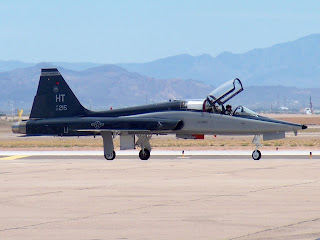This is a special thank you to the Veteran's and their familys. Thank you so much for your sacrificial.
Friday, November 11, 2011
Tuesday, November 8, 2011
Northrop White rocket
As a kid you fond memories your first tricycle or Bicycle with training wheels, May of the US and NATO Air Forces pilots the Nortrop T-38 Talon is that aircraft that they remember. The “White Rocket” as it is call has served for over 50 years. In this blog I am going to just go over a bit of the history of this aircraft beginning, in later blogs I will go in depth more on it usage today. So this migh be what you would call part one.
In the mid-1950s, Northrop started development on a low-cost, low-maintenance fighter, with the company designation N-156, partly to meet a US Navy requirement for a jet fighter to operate from its Escort Carriers, which were too small to operate the Navy's existing jet fighters. That requirement disappeared when the Navy decided to withdraw the Escort Carriers, but Northrop continued development of the N-156, with both a two seat advanced trainer (the N-156T), and a single-seat fighter (the N-156F) planned.
The N-156T was selected by the United States Air Force as a replacement for the Lockheed T-33 Shooting Star in July 1965, allowing development of the trainer to progress at full speed, the first example, later designated YT-38 Talon, is a twin-engine supersonic jet trainer flying on 12 June 1959 with a total of 1,158 Talons being built by the time production ended in January 1972. The Northrop T-38 Talon it was the world's first supersonic trainer and is also the most produced. Most T-38s built were of the T-38A variant, but the USAF also had a small number of aircraft that had been converted for weapons training. These aircraft (designated AT-38B) had been fitted with a gunsight and could carry a gunpod, rockets, or bombs on a centerline pylon.
Student pilots fly the T-38A to learn supersonic techniques, aerobatics, formation, night and instrument flying and cross-country navigation. More than 60,000 pilots have earned their wings in the T-38A. Test pilots and flight test engineers are trained in T-38A's at the U.S. Air Force Test Pilot School at Edwards Air Force Base, Calif. Air Force Materiel Command uses T-38A's to test experimental equipment such as electrical and weapon systems.
Advanced training for the bomber-fighter track is accomplished using the T-38 Talon and prepares pilots for transition to fighter and bomber aircraft. The T-38 is a tandem seat twin-engine supersonic jet. There is increased emphasis on formation, navigation, and low level navigation flying. Training takes approximately 26 weeks and includes 381 hours of ground training, 31.6 hours in the flight simulator and 118.7 flying hours in the T-38.
In 2000, over 500 T-38s, AT-38Bs were still operational with the USAF and were upgraded to the T-38C though a program called Pacer Classic the structural life extension program for the T-38, is integrating 10 modifications, including major structural renewal, Improvements include the addition of a HUD, GPS, INS (Inertial Navigation System), and TCAS as well as PMP (a propulsion modification to improve low-altitude engine thrust). This will to extend their service life to 2020.
Subscribe to:
Comments (Atom)







